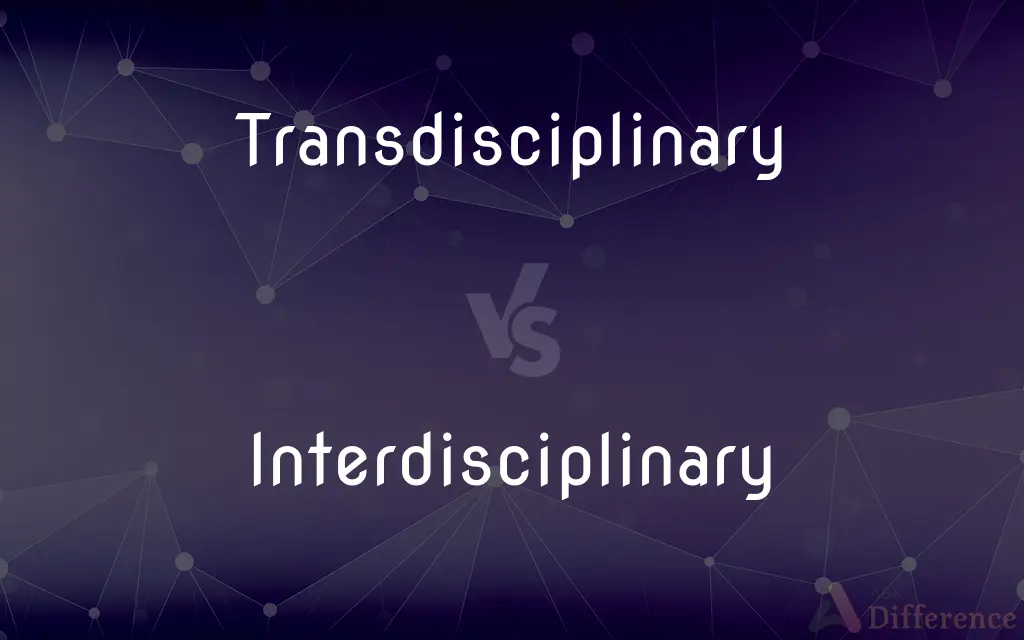Why Interdisciplinary And Transdisciplinary Approaches Matter

Table of Contents
Enhanced Problem-Solving through Integrated Perspectives
Complex problems rarely fit neatly into the confines of a single discipline. Integrated thinking, a core principle of interdisciplinary and transdisciplinary work, recognizes this. By bringing together diverse perspectives – from the natural sciences and social sciences to the humanities and engineering – we unlock significantly enhanced problem-solving capabilities. The merging of different fields fosters increased creativity and innovation, leading to solutions that are more comprehensive and effective than those generated within isolated disciplines.
- Increased creativity and innovation: The collision of different ideas and methodologies sparks unexpected insights and opens new avenues for exploration.
- Identification of blind spots and biases: Individual disciplines often have inherent biases and limitations in their perspectives. An interdisciplinary approach helps identify and mitigate these, leading to more robust and unbiased solutions.
- Development of more holistic and sustainable solutions: Considering multiple viewpoints ensures that solutions are not only effective but also sustainable and equitable in the long term.
For example, the successful development of sustainable urban planning initiatives often relies on the collaboration of architects, engineers, urban planners, sociologists, and environmental scientists. This multidisciplinary teamwork allows for a holistic approach, incorporating considerations of infrastructure, social equity, and environmental impact.
Fostering Collaboration and Knowledge Exchange
Effective interdisciplinary and transdisciplinary work hinges on robust collaboration and knowledge exchange. While this presents challenges – differing terminologies, methodologies, and even communication styles can create barriers – the rewards far outweigh the difficulties. Overcoming these requires a commitment to open communication, mutual respect, and a willingness to learn from others.
- Improved communication and understanding: Open dialogue and shared learning experiences foster mutual understanding and respect between researchers and practitioners from different backgrounds.
- Breaking down silos and fostering a more collaborative research environment: Collaborative research initiatives help to break down the traditional barriers between disciplines, promoting a culture of knowledge sharing and mutual support.
- Sharing of knowledge and resources to accelerate progress: By pooling resources and expertise, interdisciplinary teams can accelerate progress and achieve outcomes that would be impossible for individual disciplines to achieve alone.
Successful collaborative research requires carefully planned strategies to ensure effective communication and coordination. This includes establishing clear communication protocols, utilizing collaborative tools, and fostering a culture of inclusivity and mutual respect within the research team.
Achieving Broader Impact and Real-World Applications
The ultimate measure of success for any research endeavor is its real-world impact. Interdisciplinary and transdisciplinary approaches are inherently better positioned to achieve this. By tackling problems holistically and considering diverse perspectives, these approaches lead to solutions that are more relevant, applicable, and impactful.
- Development of solutions that are more relevant and applicable to real-world problems: By integrating practical considerations from diverse fields, researchers are better equipped to develop solutions that directly address real-world needs.
- Increased societal impact and contribution to public good: The integrated nature of these approaches often leads to tangible benefits for society, impacting public health, environmental protection, and economic development.
- Improved policy-making and decision-making informed by diverse perspectives: Evidence-based policy-making benefits immensely from the comprehensive insights provided by interdisciplinary research.
Consider the impact of interdisciplinary research in healthcare: advancements in personalized medicine, for instance, rely on the integration of genomic data, clinical expertise, and behavioral sciences to tailor treatments to individual patients. Similarly, effective responses to climate change require collaborative work across environmental science, economics, policy, and social sciences.
Addressing Complex Challenges through a Holistic Lens
Many of the world's most pressing problems—from climate change to pandemics—are inherently complex and interconnected. They demand a holistic approach that transcends the limitations of individual disciplines. This holistic approach, characterized by systems thinking, is where interdisciplinary and transdisciplinary approaches truly shine.
- A more comprehensive understanding of complex issues, considering multiple factors and perspectives: These integrated approaches allow for a more nuanced and complete understanding of complex problems by accounting for multiple interacting factors.
- Effective integration of knowledge from diverse fields to address interconnected problems: By combining knowledge and expertise from different fields, we gain the tools to more effectively tackle interconnected challenges.
- Ability to tackle multifaceted challenges with a systems-thinking approach: A systems thinking approach allows researchers to grasp the intricate relationships and feedback loops within complex systems, leading to more sustainable and effective solutions.
Adopting a holistic lens helps researchers understand the unintended consequences of single-disciplinary interventions, thereby leading to more sustainable and beneficial solutions. For example, tackling poverty effectively requires a multifaceted approach that integrates economic policies, social support systems, and educational initiatives.
Conclusion: Embracing Interdisciplinary and Transdisciplinary Approaches for a Brighter Future
In conclusion, the advantages of interdisciplinary and transdisciplinary approaches are clear: improved problem-solving, enhanced collaboration, and significantly greater impact. These methods are not merely academic exercises but essential tools for addressing the complex challenges facing our world and building a more sustainable and equitable future. Explore opportunities for interdisciplinary collaboration in your field, and integrate transdisciplinary thinking into your next project to achieve greater impact. Embrace these approaches, and let's collectively work towards a brighter future through the power of integrated knowledge and collaborative action.

Featured Posts
-
 Trump Supporter Ray Epps Defamation Suit Against Fox News Jan 6 Falsehoods Claim
May 19, 2025
Trump Supporter Ray Epps Defamation Suit Against Fox News Jan 6 Falsehoods Claim
May 19, 2025 -
 Find The Answers Nyt Mini Crossword March 12 2025
May 19, 2025
Find The Answers Nyt Mini Crossword March 12 2025
May 19, 2025 -
 Nyt Mini Crossword Answers For March 6 2025
May 19, 2025
Nyt Mini Crossword Answers For March 6 2025
May 19, 2025 -
 Legendary Singer Johnny Mathis Announces Retirement At 89
May 19, 2025
Legendary Singer Johnny Mathis Announces Retirement At 89
May 19, 2025 -
 Starving Artist Or Star Wife A Look At Income Disparities
May 19, 2025
Starving Artist Or Star Wife A Look At Income Disparities
May 19, 2025
